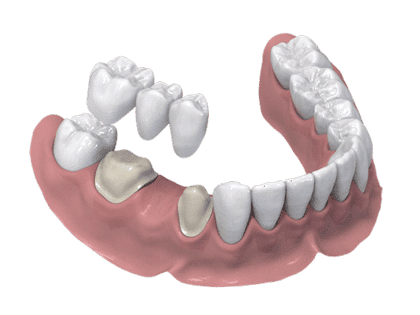Crowns and Bridges
A professionally fitted bridge or crown should last at least 10 years, provided you follow a proper dental hygiene regime. Many people have them for the rest of their lives without any problems provided they don’t do anything detrimental to their teeth, like smoking.

Request free phone consultation!
Dental Crowns
A crown (often referred to as a “cap”) is typically used to restore a tooth that is too badly decayed, broken or cracked to be restored with a filling. The existing tooth is reshaped, removing the damaged or diseased portion, and a crown shaped to resemble a real tooth is placed over it.
Crowns and Bridges: Besides being used to restore damaged teeth, crowns are needed for teeth that have had root canals.
They are also placed on dental implants to replace missing teeth. Crowns traditionally have been made entirely of gold or porcelain that is fused to a gold substrate for extra strength. While these are both excellent approaches, new technology allows for crowns to be made entirely from high-strength ceramic and porcelain which enables better color matching the existing teeth.
Metal crowns fused into porcelain have proven to irritate the gum and also show a black line around your gum with time. That’s why in Costa Rica Dental Team we have metal-free crowns.
Regardless of which type of crown you choose, you can count on the highest quality dental work at Costa Rica Dental Team. Your new crown will look and feel great!
Why are dental crowns needed?
- To restore an implant.
- Badly decayed teeth.
- Fractured or chipped teeth.
- A missing tooth (or teeth).
- To cover a dental implant.
- To restore worn-out teeth due to bruxism.
- Correcting the “sunken face” look associated with missing teeth.


Dental Bridges
As the word implies, a “bridge” literally bridges the gap created by one or more missing teeth. A bridge is comprised of two crowns for the teeth on either side of the gap and a false tooth (or teeth) in between. These false teeth are called pontics and can be made from gold, alloys, porcelain or a combination of these materials. The resulting dental bridge is supported by natural teeth or implants.
Bridges are needed not merely for cosmetic reasons, but because a missing tooth can cause serious problems with shifting teeth. A gap between your teeth can also make it difficult to chew and speak clearly—particularly when teeth are missing in the front or rear of your mouth.
Our dentists will help you make an informed decision on which sort of bridge is best for you. Costa Rica Dental Team has the experience and the expertise to create a beautiful, comfortable bridge that will provide you with many years of trouble-free use.


Types of dental bridges:
Traditional bridges
Are the most common. A crown is made for the tooth (or implant) on either side of the missing tooth, with a pontic (false tooth) in between. Material used is either porcelain fused to metal or ceramic.
Zirconia bridges
Are made from Zirconium oxide, an extremely tough dental ceramic. Compared to conventional bridges, there is less tooth sensitivity, no gray coloration around the edge of the gums, and no problems with allergic reactions.
The Procedures in Detail
Both crown and bridge procedures require two visits to the dentist. On the first appointment, the dentist prepares the tooth or teeth that are going to support the crowns. He or she does this by administering a local anesthetic. The dentist removes the filling and the damaged part of the tooth until it is ready for the crown. When a bridge is required, the dentist performs this procedure for both teeth to the sides of the gap that will hold the artificial tooth in place.
The dentist may choose to insert a temporary bridge or crown while the permanent one is being made. If that’s the case, he or she takes another impression and fashions the temporary bridge or crown with acrylic resin, then puts it in its place. You will have to come back for another appointment to fit the permanent bridge or crown.
When you return to have the permanent bridge or crown fitted, the dentist will administer another local anesthetic and remove the temporary bridge or crown if there is one. He or she cleans the teeth and sets the new, permanent bridge or crown in place, disinfecting the tooth and cleaning away any excess material. The dentist then etches the crown or bridge and it is ready to cement, a cure-led light is used to harden the cement.

How Long Do Bridges and Crowns Last?
A professionally fitted bridge or crown should last at least 15 to 20 years if the patient follows proper dental hygiene. Many people have them for the rest of their lives without any problems, if they don’t do anything detrimental to their teeth, like smoking. However, if you notice any problem with your bridge or crown, you must make an immediate appointment with your dentist to have it repaired or replaced.
While the cost varies depending on the procedure and area, on average you can expect to pay around $470 per tooth for a bridge and from $1000 to $3000 for a crown. Unfortunately, the procedures in some states cost up to twice as much.
